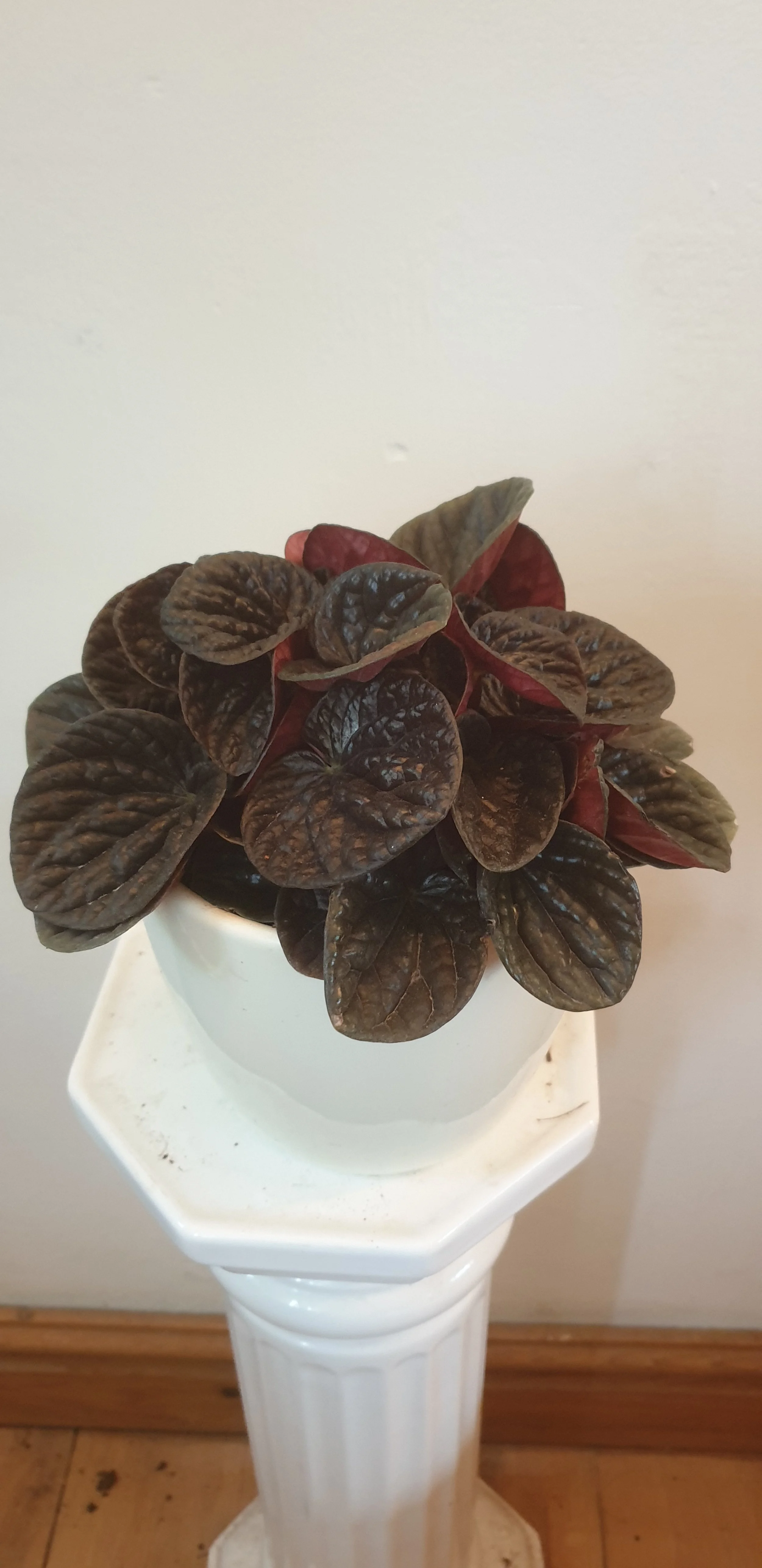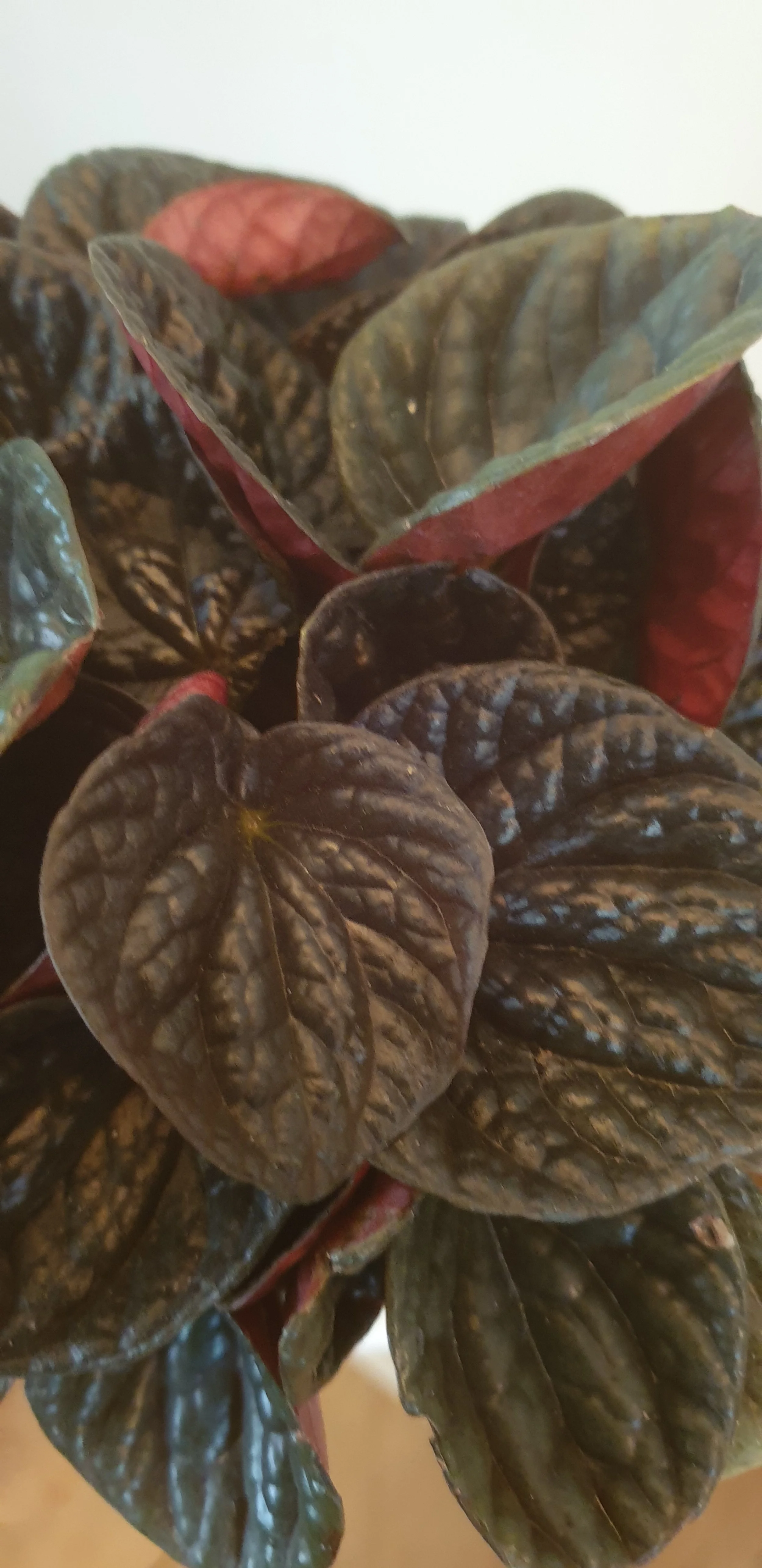 Image 1 of 2
Image 1 of 2

 Image 2 of 2
Image 2 of 2



Peperomia ' Chocolate' in 12cm pot.
Peperomia Chocolate, or Peperomia caperata ‘Chocolate’ (also ‘Chocolat’, ‘Chocolate Ripple’), is a compact, decorative houseplant known for its dark‑leaves and texture.
Leaves / Foliage: Thick, somewhat fleshy‑succulent leaves with a deep chocolate‑brown to dark brown/green top side. The underside may show red or burgundy tones. Surface often has rippled or corrugated texture (wrinkled or ridged) which adds visual interest.
Size / Growth Habit: Small, bushy, compact plant. It tends to form a dense clump rather than trailing. Height (with pot) is typically ~15‑20 cm in mature indoor specimens.
Texture & Color: Velvet‑like texture; colors are rich, moody, somewhat subdued — perfect for accenting other foliage.
---
🪴 Care Guide
This plant is relatively easygoing, but its dark foliage and texture mean a few key points make a big difference to keep it looking its best.
Requirement Best Conditions / Tips
Light Bright, indirect light is ideal. Avoid strong direct sunlight, which can scorch the leaves or bleach out the color. In lower light, growth will slow and foliage may become less vivid.
Watering Let the top soil dry out slightly between waterings. The leaves are somewhat succulent, so the plant tolerates slight dryness better than soggy soil. Overwatering is a common cause of root rot.
Humidity Appreciates moderate to high humidity, but does fine in average home humidity especially if other needs are met. If air is very dry (central heating etc.), occasional misting or a humidity tray helps.
Temperature Prefers warm indoor temps — roughly 18‑26 °C (65‑80 °F). Protect from cold drafts or sudden drops below ~12‑15 °C.
Soil / Potting Mix Well‑draining soil rich in organic matter. A general houseplant or tropical plant mix, possibly lightened with perlite or bark, works well. Soil should retain some moisture without staying waterlogged.
Fertilizer Light feeding in active growth season (spring‑summer). A balanced houseplant fertilizer, diluted, every ~4‑6 weeks is usually sufficient. Avoid overfertilizing.
Propagation Can be propagated from leaf cuttings or stem cuttings with a node. Because it’s compact, it’s quite forgiving.
Pruning & Maintenance Remove any dead or damaged leaves to keep plant tidy. Rotate pot occasionally to have even light exposure, which helps foliage look symmetrical and maintain rich color.
Repotting Only repot when rootbound or soil has compacted/broken down. Because it's slow‑to‑moderate growing, it rarely needs frequent repotting.
---
⚠️ Common Problems & Troubleshooting
Leaf scorch or bleached patches — from too much direct sunlight. Move to more filtered light.
Yellowing leaves or soggy soil — low drainage or overwatering. Let soil dry a bit; ensure pot has drainage holes.
Leaves brittle or breaking — could be from handling, low humidity, or very low temperatures. Handle gently and keep conditions stable.
Loss of color or dull foliage — usually light too low. Increase indirect brightness.
---
🐾 Pet Safety
Yes — Peperomia Chocolate (i.e. Peperomia caperata ‘Chocolate’ etc.) is non‑toxic to cats and dogs. It’s a good pet‑friendly option for a moody foliage plant.
Peperomia Chocolate, or Peperomia caperata ‘Chocolate’ (also ‘Chocolat’, ‘Chocolate Ripple’), is a compact, decorative houseplant known for its dark‑leaves and texture.
Leaves / Foliage: Thick, somewhat fleshy‑succulent leaves with a deep chocolate‑brown to dark brown/green top side. The underside may show red or burgundy tones. Surface often has rippled or corrugated texture (wrinkled or ridged) which adds visual interest.
Size / Growth Habit: Small, bushy, compact plant. It tends to form a dense clump rather than trailing. Height (with pot) is typically ~15‑20 cm in mature indoor specimens.
Texture & Color: Velvet‑like texture; colors are rich, moody, somewhat subdued — perfect for accenting other foliage.
---
🪴 Care Guide
This plant is relatively easygoing, but its dark foliage and texture mean a few key points make a big difference to keep it looking its best.
Requirement Best Conditions / Tips
Light Bright, indirect light is ideal. Avoid strong direct sunlight, which can scorch the leaves or bleach out the color. In lower light, growth will slow and foliage may become less vivid.
Watering Let the top soil dry out slightly between waterings. The leaves are somewhat succulent, so the plant tolerates slight dryness better than soggy soil. Overwatering is a common cause of root rot.
Humidity Appreciates moderate to high humidity, but does fine in average home humidity especially if other needs are met. If air is very dry (central heating etc.), occasional misting or a humidity tray helps.
Temperature Prefers warm indoor temps — roughly 18‑26 °C (65‑80 °F). Protect from cold drafts or sudden drops below ~12‑15 °C.
Soil / Potting Mix Well‑draining soil rich in organic matter. A general houseplant or tropical plant mix, possibly lightened with perlite or bark, works well. Soil should retain some moisture without staying waterlogged.
Fertilizer Light feeding in active growth season (spring‑summer). A balanced houseplant fertilizer, diluted, every ~4‑6 weeks is usually sufficient. Avoid overfertilizing.
Propagation Can be propagated from leaf cuttings or stem cuttings with a node. Because it’s compact, it’s quite forgiving.
Pruning & Maintenance Remove any dead or damaged leaves to keep plant tidy. Rotate pot occasionally to have even light exposure, which helps foliage look symmetrical and maintain rich color.
Repotting Only repot when rootbound or soil has compacted/broken down. Because it's slow‑to‑moderate growing, it rarely needs frequent repotting.
---
⚠️ Common Problems & Troubleshooting
Leaf scorch or bleached patches — from too much direct sunlight. Move to more filtered light.
Yellowing leaves or soggy soil — low drainage or overwatering. Let soil dry a bit; ensure pot has drainage holes.
Leaves brittle or breaking — could be from handling, low humidity, or very low temperatures. Handle gently and keep conditions stable.
Loss of color or dull foliage — usually light too low. Increase indirect brightness.
---
🐾 Pet Safety
Yes — Peperomia Chocolate (i.e. Peperomia caperata ‘Chocolate’ etc.) is non‑toxic to cats and dogs. It’s a good pet‑friendly option for a moody foliage plant.